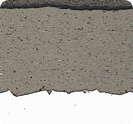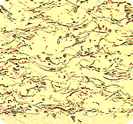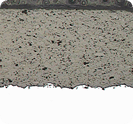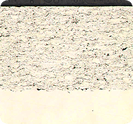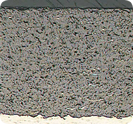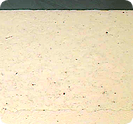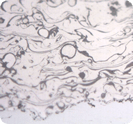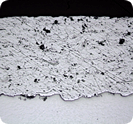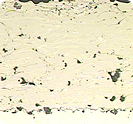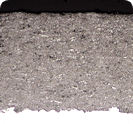Thermal Spray Materials
Thermal Spray Material Descriptions
Materials
Alumina Titania
An abrasion-resistant moderate-hardness ceramic, aluminum oxide and titanium dioxide, also know as alumina titania is particularly well suited to applications prone to erosion by fine particles. It is also a good candidate for textile wear applications. Operating environment should be < 1,000°F.
Aluminum
Elemental aluminum exhibits good electrical conductivity and is best known for its corrosion protection characteristics. It tends to oxidize more readily than steels and can prevent corrosion of most steels by “capturing” oxygen atoms before they reach the protected surface. Polishes readily, and may be built up significantly to produce solid-like structures.
Chrome Oxide
A hard, dense ceramic. Commonly used both as-sprayed and finish-ground. Highly resistant to sliding and abrasive wear, cavitation, and corrosion. Low coefficient of friction makes chrome carbide especially useful in combating adhesive wear applications in harsh and corrosive environments.
Chrome Carbide
An extremely hard metallic. Superior hardness and resistance to abrasion. Chromium carbide can exhibit some brittleness depending on the method of application. Overall, exhibits good corrosion resistance, outstanding resistance to abrasive and fretting wear and erosion, and performs well at elevated temperatures.
Chrome Oxide
A hard, dense ceramic. Commonly used both as-sprayed and finish-ground. Highly resistant to sliding and abrasive wear, cavitation, and corrosion. Low coefficient of friction makes chrome carbide especially useful in combating adhesive wear applications in harsh and corrosive environments.
Cobalt Alloys
Cobalt, alloyed variously with chromium, tungsten, carbon, molybdenum, nickel, and iron, yields exceptional hardness and durability due primarily to high chrome carbide content. Additionally, these alloys remain stable and functional through a vast temperature range, making them ideal for combating abrasive wear and fretting in high-temperature environments.
Copper
Elemental copper, like elemental aluminum, is an excellent conductor of electricity and heat; used for EMI/RFI shielding. Coatings are typically dense, making them ideal for dimensional restoration of copper-based components. Also, like aluminum, copper may be heavily built up to form solid-like structures. Used as a low-temperature mold-making alternative to casting.
Hastalloy®
A proprietary alloy of Haynes International, Inc., Hastalloy® exhibits excellent resistance to corrosion, and is an excellent candidate for repair or rebuild of equipment intended for use in and susceptible to highly corrosive environments.
(Hastalloy® is a registered trademark of Haynes Industries, Inc.)
Molybdenum
Elemental molybdenum. Demonstrates good bonding characteristics and is often used as a bond coat material under both metallics and ceramics. Good wear resistance and ability to retain lubrication make molybdenum a good choice for repair/rebuild of bearing and other wear surfaces in heavy machinery.
Molybdenum Alloys
Particularly the self-fluxing alloys with nickel, chromium, or aluminum. Hard-wearing, essentially oxide-free coatings. Extremely durable and capable of significant buildup. Wear-resistance characteristics make these coatings especially adequate for protection from harsh abrasive particulate environments.
Nickel Alloys
Particularly the self-fluxing alloys with nickel, chromium, or aluminum. Hard-wearing, essentially oxide-free coatings. Extremely durable and capable of significant buildup. Wear-resistance characteristics make these coatings especially adequate for protection from harsh abrasive particulate environments.
Self-Fluxing Alloys
Nickel or cobalt based with one or more of the following: chromium, iron, boron, silicon, tungsten carbide, copper, or molybdenum. This term covers a range of alloyed materials that have been engineered to perform best after having undergone a high-temperature fusing process. Self-fluxing alloys are applied using a standard thermal spray system, such as flame spray, and then the coating and substrate are flame- or induction-heated until the coating material begins to liquefy and flow over the surface of the part. The fusing process leaves a coating that is structurally and, at times, chemically different from the material applied.
Stainless Steels
Corrosion-resistant steel (iron, carbon) with manganese, chromium, silicon, and one or more of the following: nickel, molybdenum, zirconium, selenium, and others. Grades of stainless steel offer varying degrees of corrosion resistance and malleability. Stainless steels offer excellent machinability and corrosion resistance with good or better wear resistance.
Tungsten Carbide
A very hard metallic with superior wear resistance. Ideal for long-wearing surfaces and edges. Tungsten carbide coating materials may be ground and superfinished to provide an extremely hard mirror-like finish, although carbide coatings are also frequently used as-sprayed for a durable abrasive or wear-resistant protective surface.
Yttria Zirconia
A durable thermal barrier. Yttria zirconia produces a hard, abrasion-resistant surface with excellent thermal stability and thermal shock resistance. High specific heat capacity (SHC) provides a very low rate of heat transfer, even at extreme temperatures, making yttria zirconia ideal for protecting heat-sensitive surfaces and componenture in high-heat environments.
Zinc
Elemental zinc, like aluminum and copper, provides good electrical conductivity. Can be used in EMI/RF shielding applications. Provides galvanic and sacrificial corrosion resistance similar to aluminum. May be spray-deposited to significant thicknesses allowing for the formation of freestanding solid-like structures.
Al-O-Lox™, Com-O-Lox™, Crom-O-Lox™, Met-O-Lox™:
HAYDEN’s trademarked line of high-performance surfaces. Developed to meet the wear and corrosion challenges that we encounter most frequently, these coatings are field-proven to provide outstanding performance in a variety of applications. As with any of the materials listed here, specific material data, such as typical hardness, methods of application, and corrosion performance, are available from our applications engineers and salespeople. E-mail or call us at your convenience.
Questions? We're here to help!
Contact Hayden Corporation
(413) 734-4981 or
Contact Us Online
Questions?
Our staff is always available to answer your questions.
Categories

